|
Return to Home
Page
Picture
Archives
Email The Old Ammo Guy |
Home of the Old Ammo Guy's Virtual
Cartridge Trading Table
Picture Page
September 2018
Please note: Unless otherwise
indicated, the pictures on this web site are my property, and should not
be used by anyone without crediting the source.
The Centennial Expo .45-70 draw set,
Part 2...
I was contacted in
early May of 2013 by a gentleman from Minnesota who had inherited a
Centennial Exposition .45-70 draw set from his father some 20 years prior
that he was interested in selling. Looking over the photograph he sent
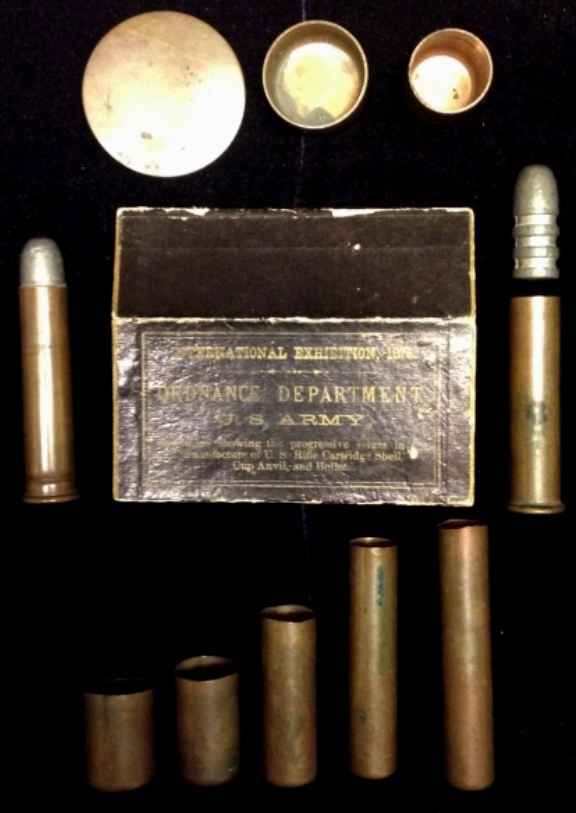 (shown
here), I was surprised to see that the black cover of the box with it's gold
labeling was still present and in very good condition, although the sliding
tray portion was missing. In the exchange of emails that followed over a
period of 2 1/2 weeks, we were unable to reach a deal and, somewhat
reluctantly, I had to let it go. Fast forward to this past March and I received an email from
this same gentleman, once again wanting to know if I was interested in the
draw set. Another weeks worth of exchanged emails followed and I was
successful in buying the set for a little less than he had originally asked
in 2013 but a bit more than I had offered at that time, as well. After
another week and a half of waiting for the completion of what had been a five year process, it
finally arrived. (shown
here), I was surprised to see that the black cover of the box with it's gold
labeling was still present and in very good condition, although the sliding
tray portion was missing. In the exchange of emails that followed over a
period of 2 1/2 weeks, we were unable to reach a deal and, somewhat
reluctantly, I had to let it go. Fast forward to this past March and I received an email from
this same gentleman, once again wanting to know if I was interested in the
draw set. Another weeks worth of exchanged emails followed and I was
successful in buying the set for a little less than he had originally asked
in 2013 but a bit more than I had offered at that time, as well. After
another week and a half of waiting for the completion of what had been a five year process, it
finally arrived.
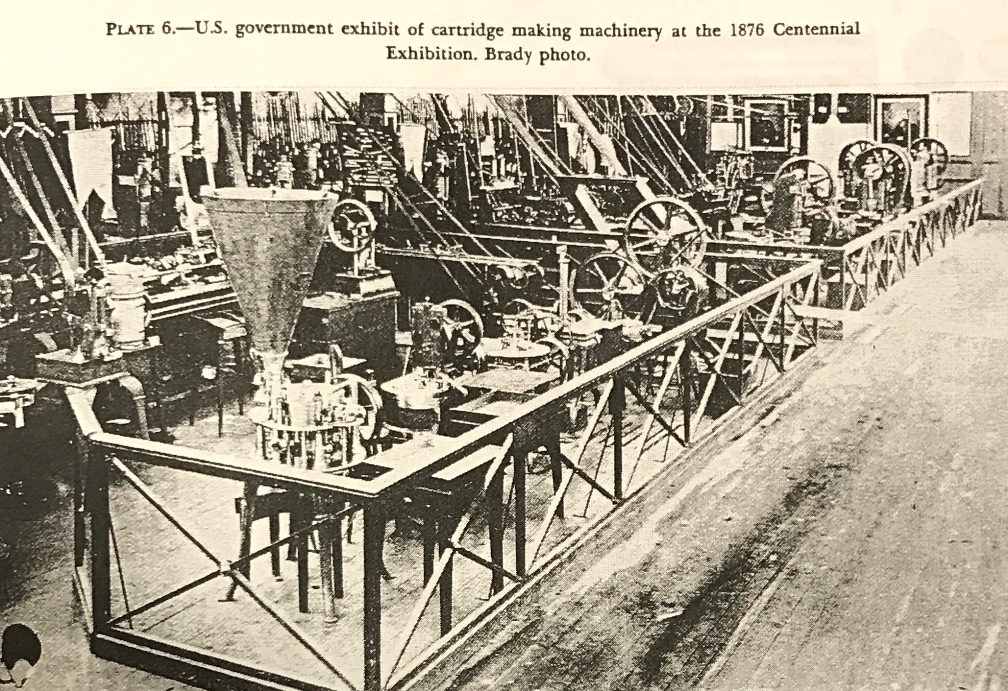 These
boxed draw sets consisted of an assortment of shaped pieces of copper and
lead that showed the stages of manufacture of the .45-70 Springfield
cartridge. They were produced on the Army Ordnance
Department's ammunition manufacturing equipment displayed at the 1876 International
Centennial These
boxed draw sets consisted of an assortment of shaped pieces of copper and
lead that showed the stages of manufacture of the .45-70 Springfield
cartridge. They were produced on the Army Ordnance
Department's ammunition manufacturing equipment displayed at the 1876 International
Centennial
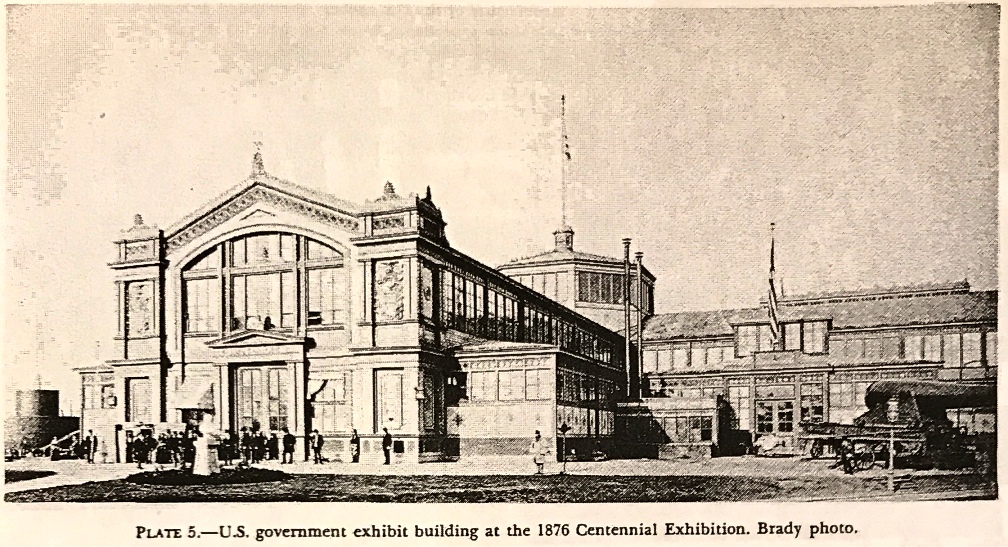 Exposition in Philadelphia. This display
was made up of all of the machinery and personnel that were required on one of the
Frankford Arsenal's cartridge manufacturing lines, which was removed from
production at the arsenal and set up in the U.S. Government display building
at the exposition. Exposition in Philadelphia. This display
was made up of all of the machinery and personnel that were required on one of the
Frankford Arsenal's cartridge manufacturing lines, which was removed from
production at the arsenal and set up in the U.S. Government display building
at the exposition.
Back in November
2005 I wrote about the first set of these
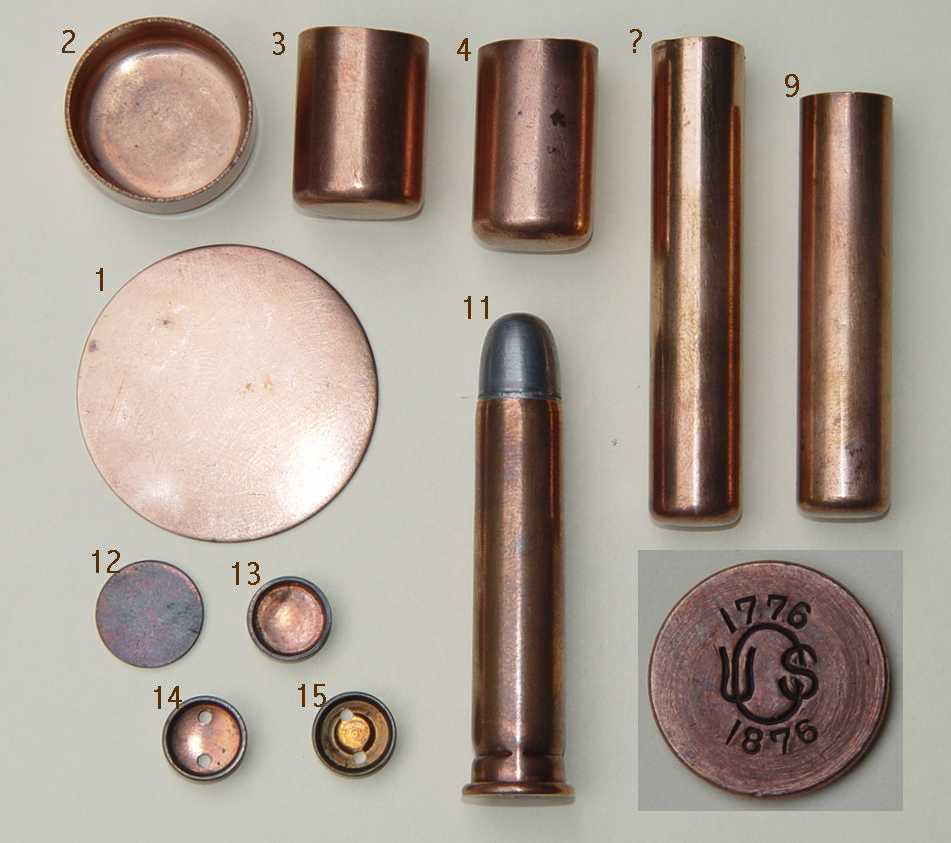 Centennial
Exposition draw sets (shown here) that I was fortunate enough to find; the write-up can be found
here. Centennial
Exposition draw sets (shown here) that I was fortunate enough to find; the write-up can be found
here.
That set did not
include the box, and consisted of a different combination of 11 pieces. The new
set is missing the stages in the production of the (primer) cup anvil, items
12 thru 15 in this photo, and my first set is missing the lead bullet,
perhaps a couple of draw pieces, and the unloaded headstamped case.
When I was writing the November 2005 article, I looked at pictures of
several other draw sets from an assortment of sources, including one from a Robert Buttweiler
1994 auction (shown below) which included 16 pieces and was described in the catalog
as the only "full
16 piece set"
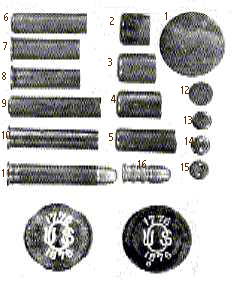 known. Items 6, 7 and 8
(please note that the numbers in the two pictures were added by me) in the
16 piece auction set were described as being intended for blank cartridges, with item 8 being a
completed blank cartridge. This wasn't actually a loaded blank cartridge, but
rather an empty finished case for a blank. That set did not include the long draw piece that
my first set had (the piece second from the top right with the question mark
in the photo above). Nor did it have the largest cup-shaped piece in the top
left corner (item #2) in the photo of my first set. Based on these
observations, I reached the conclusion that there was no such thing as a
standard or 'full' set as far as these boxed draw sets were concerned. Each boxed set,
I believe, would
have consisted of the blank copper disks for the case and cup anvil, a group
of draw pieces that showed the general progression of the stages of
production of the case and cup anvil, a bullet, an unfinished headed
cartridge case, and a finished cartridge. These last two items would have
been headstamped. known. Items 6, 7 and 8
(please note that the numbers in the two pictures were added by me) in the
16 piece auction set were described as being intended for blank cartridges, with item 8 being a
completed blank cartridge. This wasn't actually a loaded blank cartridge, but
rather an empty finished case for a blank. That set did not include the long draw piece that
my first set had (the piece second from the top right with the question mark
in the photo above). Nor did it have the largest cup-shaped piece in the top
left corner (item #2) in the photo of my first set. Based on these
observations, I reached the conclusion that there was no such thing as a
standard or 'full' set as far as these boxed draw sets were concerned. Each boxed set,
I believe, would
have consisted of the blank copper disks for the case and cup anvil, a group
of draw pieces that showed the general progression of the stages of
production of the case and cup anvil, a bullet, an unfinished headed
cartridge case, and a finished cartridge. These last two items would have
been headstamped.
Because of the
limited capacity of the box (1 1/8" x 1 3/4" x 3 1/2"), not all of the
production stages that were required to produce a complete cartridge could
be included in a set. making it necessary for the Ordnance Department
workers who were putting these boxed sets together to be selective when
pulling the various components to ensure that they would fit. The
sizes of the individual draw pieces selected determined how many would fit
in the box and therefore the number of pieces in that particular set. I do
believe however that the typical set would have included around 14 pieces.
Below is a photo
taken from The .45-70 Springfield, by Frasca & Hill. Note the dark stain on
the large blank copper disk on the upper left in the photo and compare it to
the copper disk in the Buttweiler auction set. My photo from the catalog is
poor quality, but a comparison to the original catalog photo will reveal
that they are obviously the same
disks, indicating that the two photos are of the same draw set. This is a 16
piece set if the two cases on the
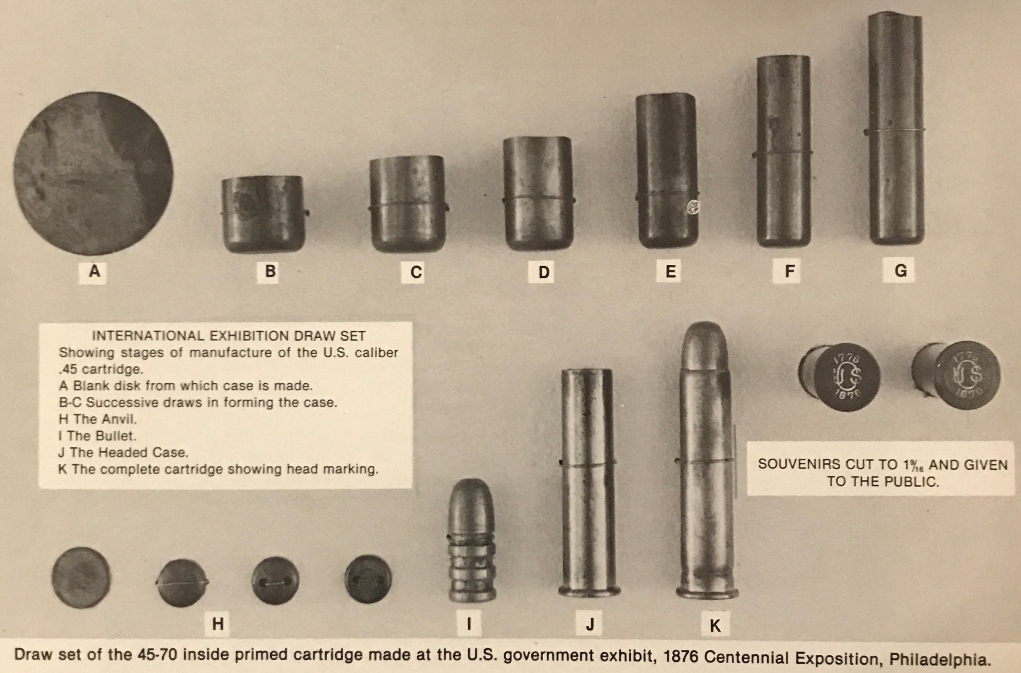
right showing their
headstamps are included, however, they probably shouldn't be. These two cartridge cases are labeled on the
display as "souvenirs cut to 1 9/16" and given to the public". This labeling
tells me that at the time this display was photographed for the book, it was
a known fact that the two short
blank-length (1 9/16") cases were not part of the original draw set,
but somewhere between the photo being taken for the book and the description
being written for the Buttweiler auction, the correct identification of the
two 1 9/16" empty blank cases was overlooked, and this 14 piece draw set
became the only "full 16 piece set" known. These two incorrectly identified
pieces are numbered 7 and 8 on the auction photo; item 6 is just another of
the draw pieces and is probably an original part of the draw set.
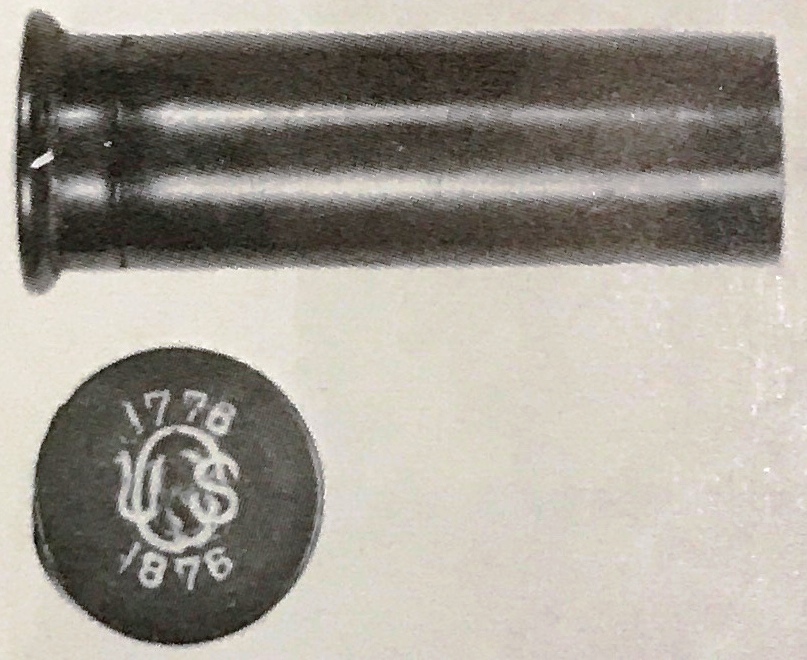 One
of these blank cases is pictured in George Hoyem's The History and
Development of Small Arms Ammunition, Vol 2. I've included the picture of
the case here. The description in the book is "Sample empty cartridge case
produced by U.S. Ordnance at the Philadelphia 1876 Exposition and presented
to attendees as souvenirs." One
of these blank cases is pictured in George Hoyem's The History and
Development of Small Arms Ammunition, Vol 2. I've included the picture of
the case here. The description in the book is "Sample empty cartridge case
produced by U.S. Ordnance at the Philadelphia 1876 Exposition and presented
to attendees as souvenirs."
Following the
close of the Centennial Exposition, a large collection of ammunition that
had been assembled for display at the exposition was moved to the museum in
the basement of the Frankford Arsenal. At the start of World War 2, all
space at the arsenal was considered critical for the war effort, and
preparations were made to scrap the collection. Fortunately, it was saved,
moved to a secure location for storage, and in 1958 sent to the
Smithsonian Institution by Colonel Berkley R. Lewis. Included in the
collection was the set of .45-70 draw pieces
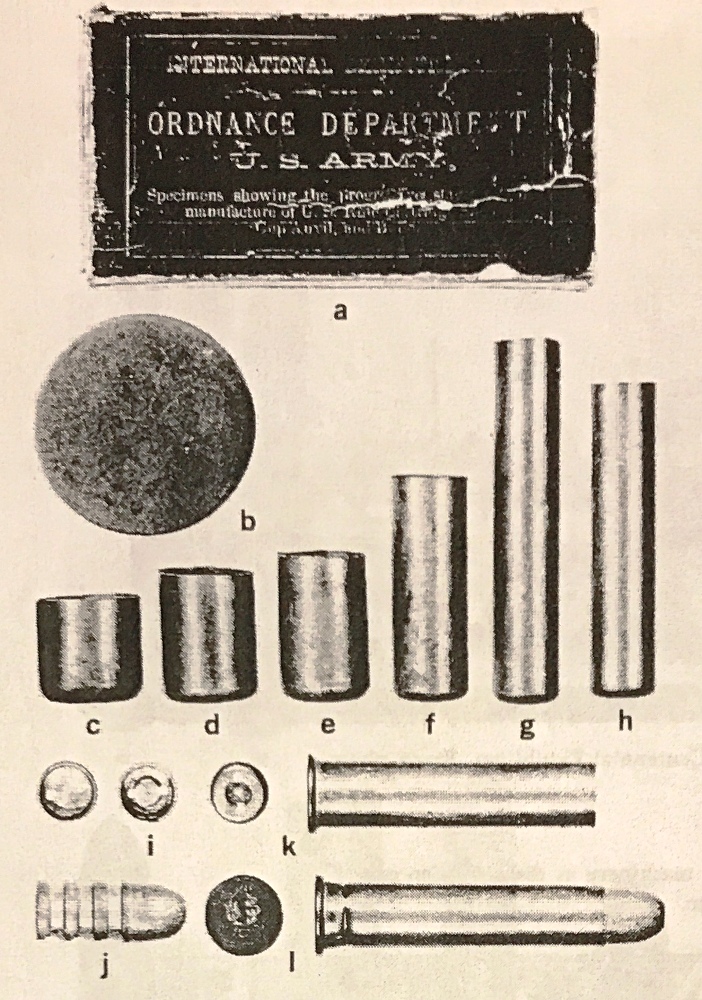 that
is pictured here with the original box. Disregarding the box, this set has 13 pieces. The head of
the cartridge at the bottom depicting the headstamp probably was not a 14th
piece, but was most likely included in the photo merely to illustrate the headstamp
that was on both the unfinished headed case (k) and the completed cartridge
(l). It should be noted that no pieces for the production of a blank
cartridge are included in the draw set that was assembled by the Ordnance
Department to be included in their museum cartridge collection. This would
provide further support that
the short blank cartridge cases were not a part of the boxed sets. that
is pictured here with the original box. Disregarding the box, this set has 13 pieces. The head of
the cartridge at the bottom depicting the headstamp probably was not a 14th
piece, but was most likely included in the photo merely to illustrate the headstamp
that was on both the unfinished headed case (k) and the completed cartridge
(l). It should be noted that no pieces for the production of a blank
cartridge are included in the draw set that was assembled by the Ordnance
Department to be included in their museum cartridge collection. This would
provide further support that
the short blank cartridge cases were not a part of the boxed sets.
I've included a
photo here of my latest draw set, arranged as c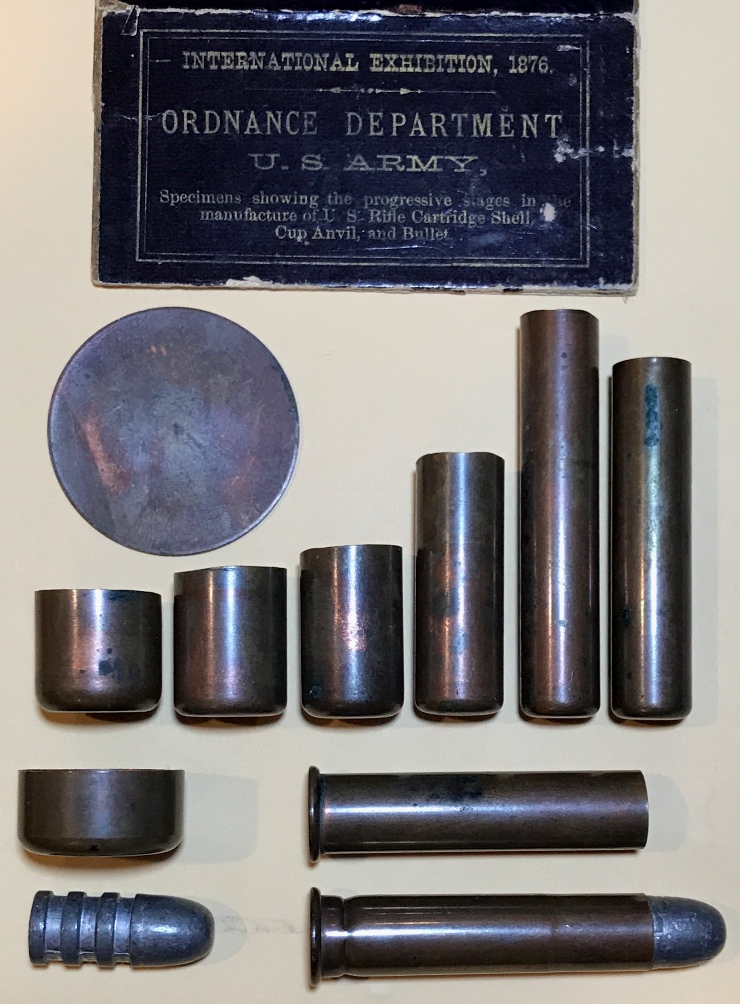 losely
as possible to the arrangement of the museum set above. Comparing the museum
set with this photo, the most obvious difference is the missing cup anvil stages that were mentioned previously, three of
which were in the museum set, and that I assume were misplaced from my set over the
years. I make this assumption because the cup anvil is specifically
mentioned in the labeling on the front of the box (see the enlarged photo
below of the front of the box), along with the cartridge
shell and the bullet, as being the component parts or 'specimens' that were
in the box, with no mention of a blank shell. But missing from the museum
set is the short wide copper cup that I have included above the bullet in
the photo above of the new set. This is the first stage of drawing out the losely
as possible to the arrangement of the museum set above. Comparing the museum
set with this photo, the most obvious difference is the missing cup anvil stages that were mentioned previously, three of
which were in the museum set, and that I assume were misplaced from my set over the
years. I make this assumption because the cup anvil is specifically
mentioned in the labeling on the front of the box (see the enlarged photo
below of the front of the box), along with the cartridge
shell and the bullet, as being the component parts or 'specimens' that were
in the box, with no mention of a blank shell. But missing from the museum
set is the short wide copper cup that I have included above the bullet in
the photo above of the new set. This is the first stage of drawing out the
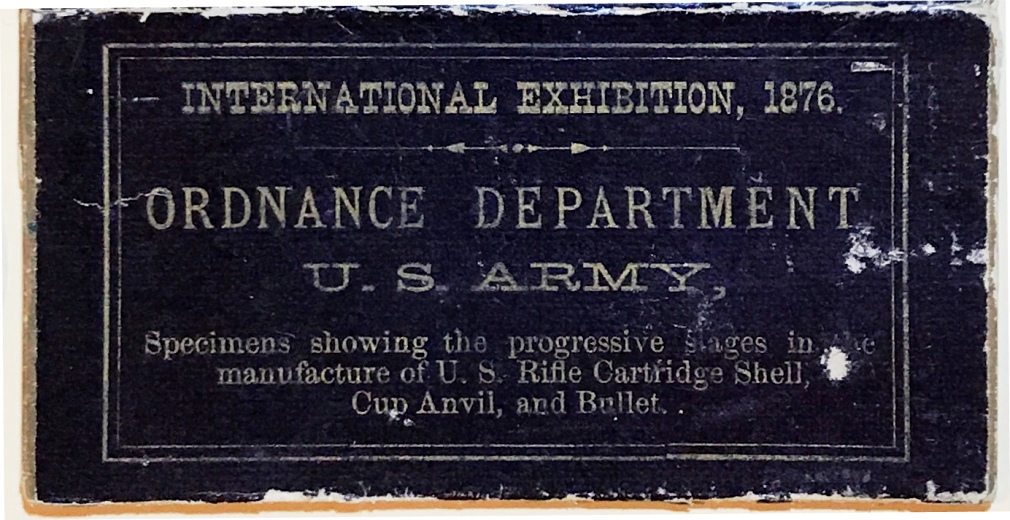 cartridge
case from the flat copper disk. I would be surprised if any of the original
components of the museum set could have been misplaced; if that is the case
it supports my belief that there was no such thing as a standard set of
components in these boxes. Incidentally, I have not seen a picture of a draw
set, besides the museum set and mine, that includes it's original box. cartridge
case from the flat copper disk. I would be surprised if any of the original
components of the museum set could have been misplaced; if that is the case
it supports my belief that there was no such thing as a standard set of
components in these boxes. Incidentally, I have not seen a picture of a draw
set, besides the museum set and mine, that includes it's original box.
Shortly after I
received the new draw set, I made the replacement sliding tray shown here to
fit the original
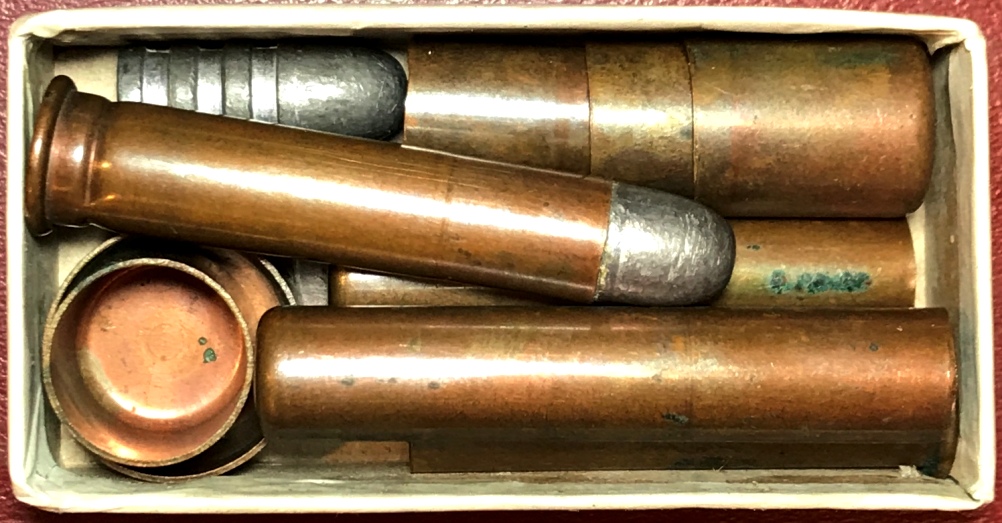 box.
While trying to pack the component pieces into this tray, it was necessary
to take full advantage of the ability to 'telescope' some of the pieces into
others in order to get all of the pieces to fit. This little exercise has convinced
me that all 16 pieces from the Buttweiler auction draw set could not be fit
into one of the boxes. box.
While trying to pack the component pieces into this tray, it was necessary
to take full advantage of the ability to 'telescope' some of the pieces into
others in order to get all of the pieces to fit. This little exercise has convinced
me that all 16 pieces from the Buttweiler auction draw set could not be fit
into one of the boxes.
.
.
.
.
Sources:
Photos of the ammunition
production line and the US Government Display Building, and general
Exposition information, Small Arms Ammunition at the
International Exposition, Philadelphia, 1876, Berkley R. Lewis, Smithsonian
Institution Press, Washington, 1972
Photo of the 16 piece draw set
from Robert Buttweiler's Collector's Ammunition auction catalog, Vol. X,
Number 1, lot 86 (1994),
Photo of 16 piece display (14 piece draw set pus 2 short souvenir cases),
The 45-70 Springfield, Albert J. Frasca and Robert H. Hill, Springfield
Pubishing Company, Northridge, California, 1980
Photo of the single short enpty case, The History and
Development of Small Arms Ammunition, Vol 2, George A. Hoyem, Armory
Publicatopns, Tacoma, Washington, 1982.
.
Return to Home
Page
.
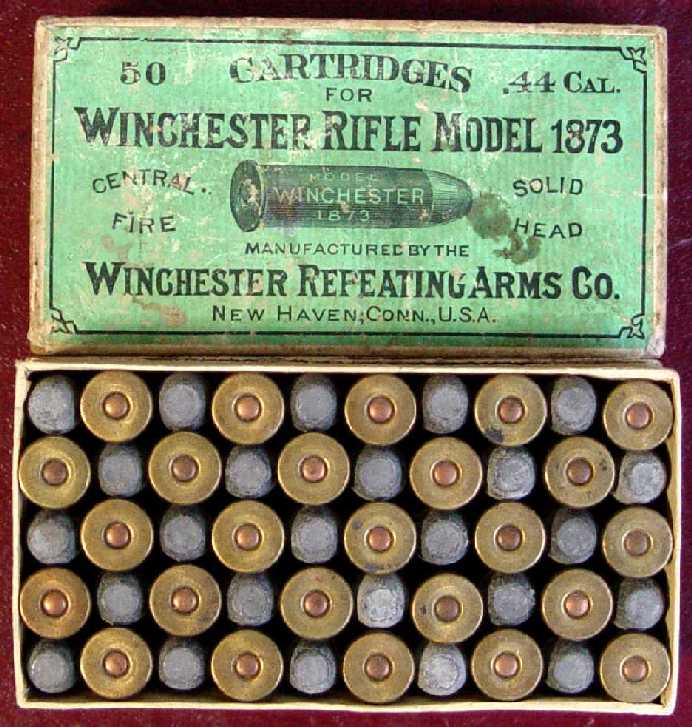
|

 (shown
here), I was surprised to see that the black cover of the box with it's gold
labeling was still present and in very good condition, although the sliding
tray portion was missing. In the exchange of emails that followed over a
period of 2 1/2 weeks, we were unable to reach a deal and, somewhat
reluctantly, I had to let it go. Fast forward to this past March and I received an email from
this same gentleman, once again wanting to know if I was interested in the
draw set. Another weeks worth of exchanged emails followed and I was
successful in buying the set for a little less than he had originally asked
in 2013 but a bit more than I had offered at that time, as well. After
another week and a half of waiting for the completion of what had been a five year process, it
finally arrived.
(shown
here), I was surprised to see that the black cover of the box with it's gold
labeling was still present and in very good condition, although the sliding
tray portion was missing. In the exchange of emails that followed over a
period of 2 1/2 weeks, we were unable to reach a deal and, somewhat
reluctantly, I had to let it go. Fast forward to this past March and I received an email from
this same gentleman, once again wanting to know if I was interested in the
draw set. Another weeks worth of exchanged emails followed and I was
successful in buying the set for a little less than he had originally asked
in 2013 but a bit more than I had offered at that time, as well. After
another week and a half of waiting for the completion of what had been a five year process, it
finally arrived.  These
boxed draw sets consisted of an assortment of shaped pieces of copper and
lead that showed the stages of manufacture of the .45-70 Springfield
cartridge. They were produced on the Army Ordnance
Department's ammunition manufacturing equipment displayed at the 1876 International
Centennial
These
boxed draw sets consisted of an assortment of shaped pieces of copper and
lead that showed the stages of manufacture of the .45-70 Springfield
cartridge. They were produced on the Army Ordnance
Department's ammunition manufacturing equipment displayed at the 1876 International
Centennial
 Exposition in Philadelphia. This display
was made up of all of the machinery and personnel that were required on one of the
Frankford Arsenal's cartridge manufacturing lines, which was removed from
production at the arsenal and set up in the U.S. Government display building
at the exposition.
Exposition in Philadelphia. This display
was made up of all of the machinery and personnel that were required on one of the
Frankford Arsenal's cartridge manufacturing lines, which was removed from
production at the arsenal and set up in the U.S. Government display building
at the exposition.  Centennial
Exposition draw sets (shown here) that I was fortunate enough to find; the write-up can be found
Centennial
Exposition draw sets (shown here) that I was fortunate enough to find; the write-up can be found

 One
of these blank cases is pictured in George Hoyem's The History and
Development of Small Arms Ammunition, Vol 2. I've included the picture of
the case here. The description in the book is "Sample empty cartridge case
produced by U.S. Ordnance at the Philadelphia 1876 Exposition and presented
to attendees as souvenirs."
One
of these blank cases is pictured in George Hoyem's The History and
Development of Small Arms Ammunition, Vol 2. I've included the picture of
the case here. The description in the book is "Sample empty cartridge case
produced by U.S. Ordnance at the Philadelphia 1876 Exposition and presented
to attendees as souvenirs."  that
is pictured here with the original box. Disregarding the box, this set has 13 pieces. The head of
the cartridge at the bottom depicting the headstamp probably was not a 14th
piece, but was most likely included in the photo merely to illustrate the headstamp
that was on both the unfinished headed case (k) and the completed cartridge
(l). It should be noted that no pieces for the production of a blank
cartridge are included in the draw set that was assembled by the Ordnance
Department to be included in their museum cartridge collection. This would
provide further support that
the short blank cartridge cases were not a part of the boxed sets.
that
is pictured here with the original box. Disregarding the box, this set has 13 pieces. The head of
the cartridge at the bottom depicting the headstamp probably was not a 14th
piece, but was most likely included in the photo merely to illustrate the headstamp
that was on both the unfinished headed case (k) and the completed cartridge
(l). It should be noted that no pieces for the production of a blank
cartridge are included in the draw set that was assembled by the Ordnance
Department to be included in their museum cartridge collection. This would
provide further support that
the short blank cartridge cases were not a part of the boxed sets. losely
as possible to the arrangement of the museum set above. Comparing the museum
set with this photo, the most obvious difference is the missing cup anvil stages that were mentioned previously, three of
which were in the museum set, and that I assume were misplaced from my set over the
years. I make this assumption because the cup anvil is specifically
mentioned in the labeling on the front of the box (see the enlarged photo
below of the front of the box), along with the cartridge
shell and the bullet, as being the component parts or 'specimens' that were
in the box, with no mention of a blank shell. But missing from the museum
set is the short wide copper cup that I have included above the bullet in
the photo above of the new set. This is the first stage of drawing out the
losely
as possible to the arrangement of the museum set above. Comparing the museum
set with this photo, the most obvious difference is the missing cup anvil stages that were mentioned previously, three of
which were in the museum set, and that I assume were misplaced from my set over the
years. I make this assumption because the cup anvil is specifically
mentioned in the labeling on the front of the box (see the enlarged photo
below of the front of the box), along with the cartridge
shell and the bullet, as being the component parts or 'specimens' that were
in the box, with no mention of a blank shell. But missing from the museum
set is the short wide copper cup that I have included above the bullet in
the photo above of the new set. This is the first stage of drawing out the
 cartridge
case from the flat copper disk. I would be surprised if any of the original
components of the museum set could have been misplaced; if that is the case
it supports my belief that there was no such thing as a standard set of
components in these boxes. Incidentally, I have not seen a picture of a draw
set, besides the museum set and mine, that includes it's original box.
cartridge
case from the flat copper disk. I would be surprised if any of the original
components of the museum set could have been misplaced; if that is the case
it supports my belief that there was no such thing as a standard set of
components in these boxes. Incidentally, I have not seen a picture of a draw
set, besides the museum set and mine, that includes it's original box.
 box.
While trying to pack the component pieces into this tray, it was necessary
to take full advantage of the ability to 'telescope' some of the pieces into
others in order to get all of the pieces to fit. This little exercise has convinced
me that all 16 pieces from the Buttweiler auction draw set could not be fit
into one of the boxes.
box.
While trying to pack the component pieces into this tray, it was necessary
to take full advantage of the ability to 'telescope' some of the pieces into
others in order to get all of the pieces to fit. This little exercise has convinced
me that all 16 pieces from the Buttweiler auction draw set could not be fit
into one of the boxes.